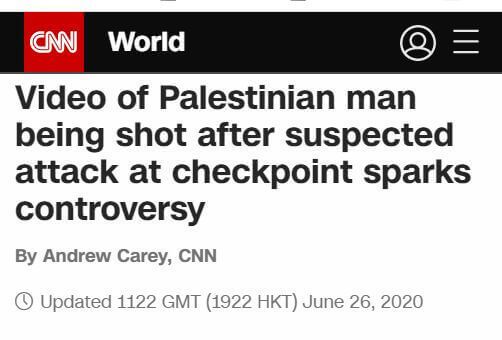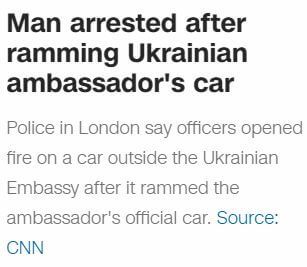Over the past months, as renewed anti-police violence protests have spread across the US, dozens of drivers have accelerated into the crowds. Vehicle rammings first gained popularity in the United States as a violent anti-protest tactic during the early waves of Black Lives Matter street-blocking protests in 2015. In Europe as well, terror-ramming attacks have increased over the last five years. And since 2015, there have been over 80 vehicular ramming attacks in Israel.
But if the amount of vehicular attacks being perpetrated around the world is increasing, why are rammings that take place in Israel either not covered by the international media, or grossly misrepresented?
Join the fight for Israel’s fair coverage in the news
Car rammings: A growing first-world problem
Most other types of terrorist attacks occur in conflict zones in the developing world. However, most vehicle ramming attacks occur in developed countries. Europe and the United States account for more than half of the recent attacks. But it was Israel that was the canary in the coal mine. Ramming attacks did not become a terrorist tactic until the 1990s, when Palestinians started carrying out vehicular assaults in Israel.
According to counter-terrorism expert Daveed Gartenstein-Ross, terrorists began using vehicles as weapons in Israel partly because, “the security barrier is fairly effective, which makes it hard to get bombs into the country.” By 2016, vehicle ramming attacks had evolved from a statistically rare event to become the second most-common form of terror attack in Israel and the second-deadliest form of attack carried out by Palestinian assailants.
As for individual countries, Israel and the Palestinian Territories lead with 41 attacks, followed by the United States with 39 attacks, China with 28, France with 14, and the United Kingdom with 10.
Vehicular attacks in Israel: Wherefore art thou media?
Even though the international press is well aware of the car ramming phenomenon, and has reported on it extensively, it tends to go MIA when it comes to coverage of vehicular attacks inside Israel. In this case, a lack of reporting is as much of a breach in journalistic ethics as biased coverage. By choosing to report certain events over others, or withholding key details, the media controls access to information. When news organizations neglect to report on a car ramming in Israel, it’s engaging in a subtle yet highly effective form of media bias, selective omission.
This matters. People today are busier than ever. They simply don’t have time to get the whole story. That’s a journalist’s responsibility. By selectively omitting stories that don’t fit into a certain narrative, journalists make it impossible for the public to fully understand events as they unfold.
Related Reading: Israelis Under Attack, Media MIA
Car attack or accident? When a terrorist act becomes ‘controversial’
In response to accusations that Israeli forces shot and killed a Palestinian without justification, Israel Border Police released security footage from the suspected car ramming attack in the West Bank. On June 26, CNN ran with this story, opening the network’s report of the incident with this headline:

Notice the word ‘suspected.’ But cold hard evidence, the aforementioned security footage, refutes the CNN headline’s allusion that the Palestinian man who was shot may not have even been involved in an attack. Check out the video of the incident and this is what you’ll see: a car being driven by the ‘Palestinian man’ approaches a checkpoint in Abu Dis, near Jerusalem. He abruptly accelerates and turns toward a group of police. His car then rams into a female officer who is knocked into the air before colliding with a booth and coming to a stop.
Another linguistic sleight of hand employed by CNN is to turn the attack from an active verb into a passive-sounding noun: ‘suspected attack.’ This has the effect of downplaying the horrendous nature of the attack.
By way of comparison, this was how CNN described a car ramming incident that took place outside of Israel:

As presented by CNN to its website readers, a Palestinian driver ramming his car into Israeli border police officers is reported as an unconfirmed allegation. A similar act that took place in the UK isn’t reported by CNN as ‘suspected,’ but as a fait accompli.
Unfortunately, this kind of imbalanced media coverage isn’t unique to CNN. Another serial offender is Reuters:


Again, the Reuters headline about the Palestinian driver being shot casts doubt as to whether he had in fact perpetrated an attack. Also, notice how ‘Israeli police’ is included. A cowardly attack like this seems less heinous if it’s perpetrated against the rather abstract ‘Israeli police,’ as opposed to real people, police officers.
Meanwhile, the second Reuters headline states the facts as they happened, without modifiers such as ‘alleged,’ ‘suspected,’ etc. Another difference is the use of the active verb ‘rams.’ Also, the victims of the Paris attack are humanized. They’re not described as ‘Paris police,’ but ‘two police motorcyclists.’
Guarding against ignorance: The high price of an uninformed citizenry
An alarming number of people no longer trust the media to report the news fairly. This is a serious problem in democratic societies where people depend on news organizations for information. People are increasingly consuming the news via their mobile devices. They aren’t in a position to fact-check, verify sources, and identify omissions. This is where good, honest reporting can make a difference in the way people view their world. By just presenting the facts, and allowing to people to reach their own conclusions without being hampered by agenda-driven journalism, news organizations can win back people’s trust.
Car ramming is no longer a distant Israeli story. Today, people around the world are increasingly being exposed to this brand of terrorism. They deserve to know the truth, the whole truth, and nothing but the truth. Ignoring, glossing over, or misrepresenting car ramming attacks in Israel makes it difficult for people in other democratic societies to get a proper perspective as to the severity and scope of the problem.
Enjoyed reading this article? Follow the HonestReporting page on Facebook to read more articles debunking news bias and smears, as well as others explaining Israel’s history, politics, and international affairs. Click here to learn more!
Featured image: image of car via flaticon.com; image of globe via flaticon.com


